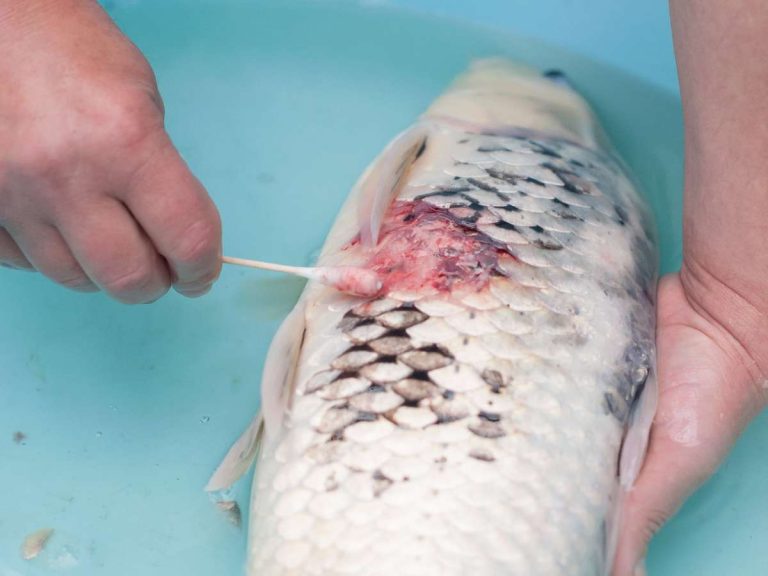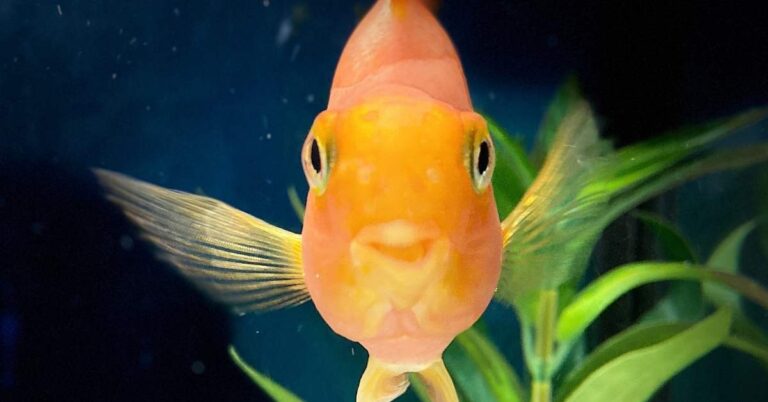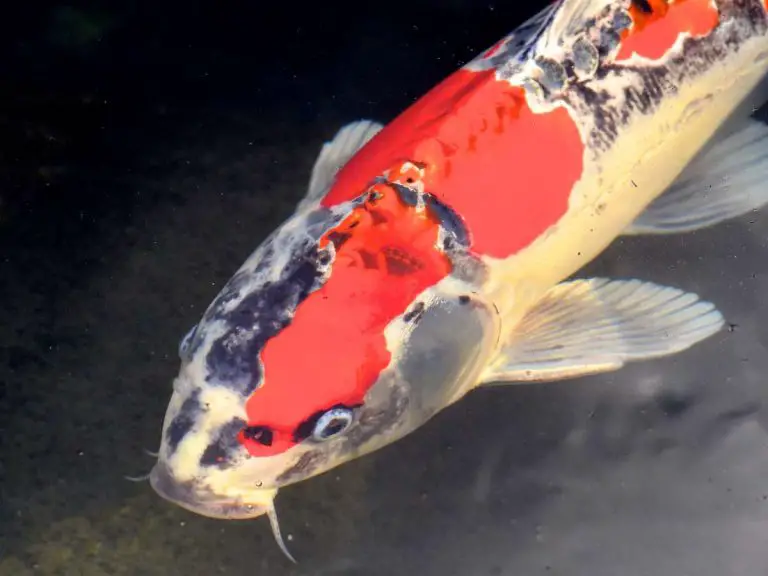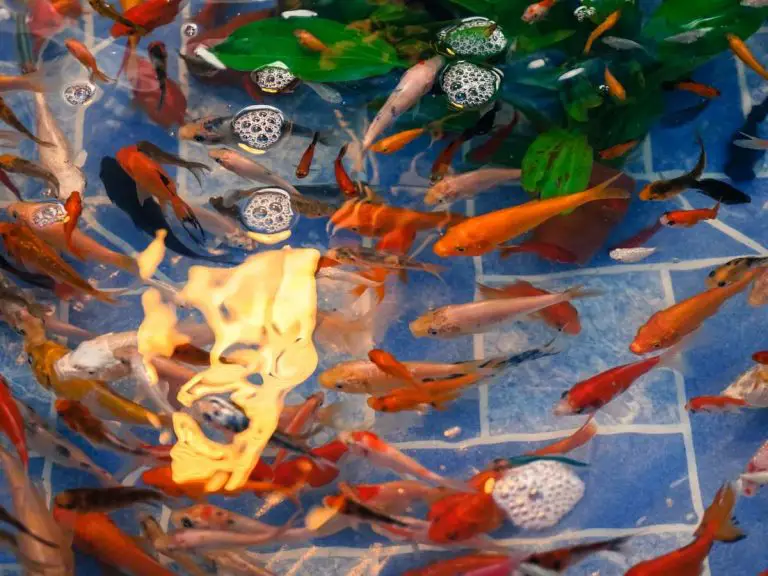Sanke Koi (Taisho Sanshoku) Guide: Everything You Need to Know for Perfect Care and Breeding
Sanke Koi, with their mesmerizing patterns and vibrant colors, have long been a symbol of grace and tranquility. Originating from Japan in the early 19th century, these ornamental fish have captured the hearts of aquarists and pond enthusiasts worldwide.
A Sanke Koi is characterized by its porcelain-like white skin (Shiro) adorned with red to red-orange markings (Hi) and distinct black patterns (Sumi). Notably, a genuine Sanke Koi should not have any Sumi markings on its head; in fact, if it does, it’s likely a Showa Koi.
As with all living creatures, the well-being of Sanke Koi hinges on understanding their needs and ensuring they are met. This article gets into the importance of Sanke Koi care, highlighting the steps needed to maintain their health, enhance their beauty, and ensure they thrive in their aquatic homes.
Whether you’re a seasoned Koi keeper or a budding enthusiast, this guide aims to equip you with the knowledge to give these magnificent creatures the care they truly deserve.
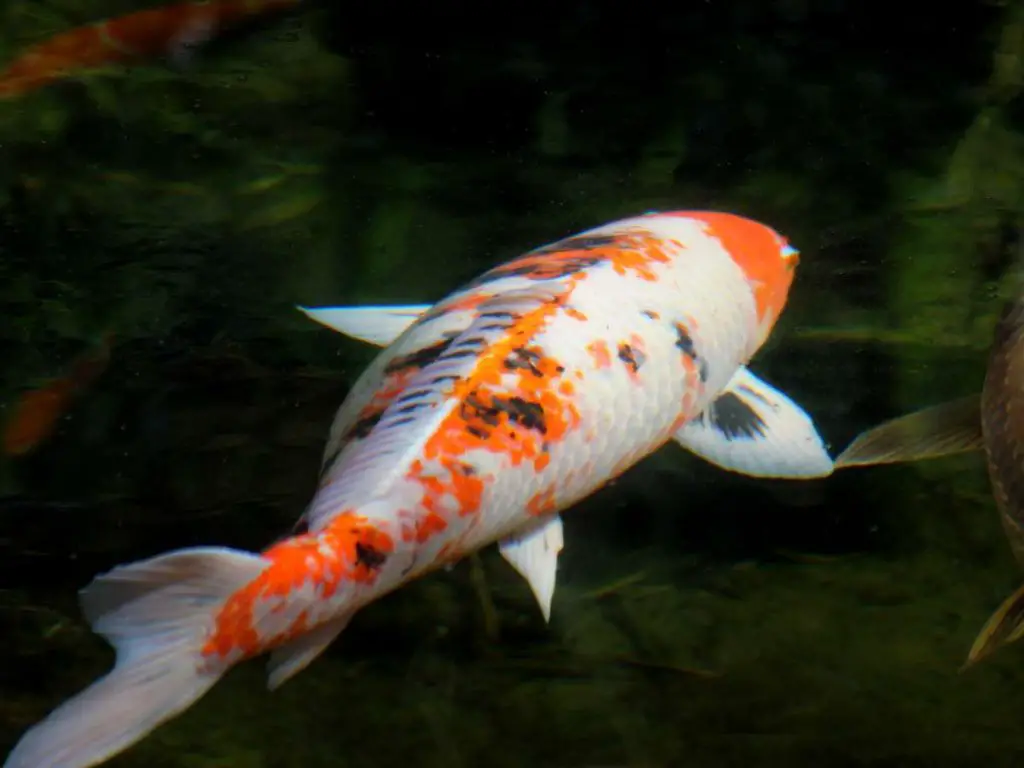
Importance of Sanke Koi Fish Care
Proper care for Sanke (Taisho Sanshoku) koi fish is crucial for their well-being and overall health. By providing them with the right conditions and attention, you can ensure not only their longevity but also their stunning beauty and vibrant colors. Let’s take a closer look at why Sanke koi fish care is so important.
Preventing Diseases and Maintaining Health:
When you give your Sanke koi fish the care they need, you significantly reduce the risk of diseases or health issues. Proper attention to water quality, feeding habits, and tank cleanliness can prevent the proliferation of harmful bacteria and viruses that may harm your fish.
Maximizing Lifespan and Beauty:
Sanke koi fish are known for their mesmerizing patterns and striking colors. By ensuring their proper care, you can enhance the longevity of these beautiful creatures. A well-maintained habitat, balanced diet, and suitable water conditions can help your Sanke koi fish thrive and showcase their full potential.
Creating a Harmonious Environment:
Just like any other living creature, Sanke koi fish thrive in an environment that meets their specific needs. With the right care, you can create a harmonious and stress-free environment in your aquarium. This includes providing them with appropriate tank size, decorations, hiding spots, and suitable water temperature and lighting conditions.
Overall, giving your Sanke koi fish proper care is a rewarding experience that not only benefits the fish but also allows you to enjoy their presence in your pond or aquarium. Now that we understand the importance of Sanke koi fish care let’s move on to our comprehensive guide to help you take the best care possible of these mesmerizing creatures.
Sanke Koi (Taisho Sanshoku) Care Guide: Everything You Need To Know
Before we get into the specifics of caring for your Sanke Koi, here are some important statistics you need to know:
| Parameter | Ideal level for Sanke Koi | Notes |
|---|---|---|
| pH Level | 7.0 – 8.5 | Neutral to slightly alkaline water is preferred. |
| Water Hardness (dGH) | 4 – 12 dGH | Soft to moderately hard water. |
| Temperature | 68°F – 78°F (20°C – 25°C) | Sanke Koi are cold-water fish but prefer this range for optimal health. |
| Ammonia (NH3) | 0 ppm | Ammonia can be toxic to fish, so it’s essential to maintain a level of 0 ppm. |
| Nitrite (NO2) | 0 ppm | Nitrite can be harmful to fish, so it’s crucial to keep this at 0 ppm. |
| Nitrate (NO3) | < 50 ppm | Lower levels are better. Regular water changes can help keep nitrate levels in check. |
| Oxygen Level | > 6 mg/L | Adequate oxygenation is vital. Using air stones or waterfalls can help increase oxygen. |
| Chlorine (Cl2) | 0 ppm | Chlorine is harmful to fish. Always dechlorinate tap water before adding it to the pond. |
| Salinity | 0.1% – 0.3% | Some Koi keepers use salt for health benefits, but it’s not a requirement. |
Setting up the aquarium tank
When setting up the perfect home for your Sanke koi fish, you’ll want to create a comfortable and safe environment for them to thrive. Start by choosing a tank that provides enough space for your fish to swim freely. Aim for at least 50 gallons for a single Sanke koi fish, and increase the size if you plan on having multiple fish.
Add a layer of substrate to the bottom of the tank, such as gravel or sand, to mimic their natural habitat. Make sure to rinse the substrate before adding it to remove any debris or dust that could cloud the water.
Maintaining water quality
One of the most important aspects of Sanke koi fish care is maintaining good water quality. This means regularly testing and monitoring the levels of ammonia, nitrites, nitrates, pH, and temperature in the tank.
Invest in a high-quality water filtration system that can efficiently remove waste and toxins from the water. Regularly clean and maintain the filter to ensure it works effectively.
Feeding requirements and habits
Sanke koi fish are omnivorous creatures, which means they eat both plant matter and small insects or crustaceans. You can feed them a variety of foods such as commercial fish pellets, live or frozen brine shrimp, bloodworms, or even small pieces of fresh fruits and vegetables.
It’s important to feed your Sanke koi fish small portions multiple times a day, rather than one large meal. This helps prevent overfeeding and ensures that they receive enough nutrition throughout the day. Observe their feeding habits and adjust accordingly to avoid wastage or underfeeding.
Monitoring temperature and lighting conditions
Sanke koi fish thrive in water temperatures between 72-82°F (22-28°C). Invest in a reliable aquarium heater to maintain a consistent temperature within this range.
Proper lighting is also crucial for the health and well-being of your Sanke koi fish. Provide a combination of natural daylight and artificial lighting to mimic their natural habitat. Avoid placing the tank in direct sunlight, as it can cause rapid temperature changes and promote excessive algae growth.
Handling and interacting with Sanke koi fish
When handling Sanke (Taisho Sanshoku) koi fish, it’s important to be gentle and avoid any sudden movements that could startle or stress them. Always wet your hands before touching them to prevent removing the protective slime coat on their scales.
Remember that Sanke koi fish are primarily visual creatures, so interacting with them through glass or observing them from a reasonable distance is usually best. Minimize physical contact as much as possible, unless necessary for maintenance or medical reasons.
Common Diseases and Issues Sanke Koi Face & How to Prevent or Treat Them
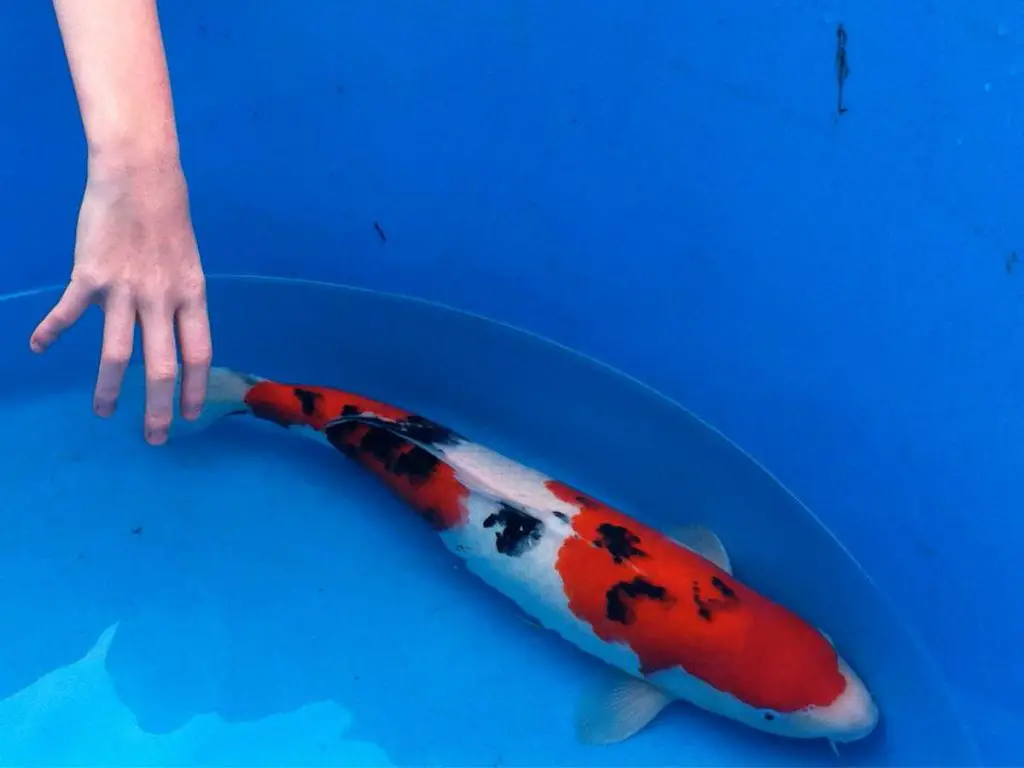
Sanke Koi, like all fish, are susceptible to various diseases and issues that can affect their health and well-being. By understanding these common problems, Koi enthusiasts can take proactive measures to prevent them or treat them effectively when they arise.
Koi Herpes Virus (KHV)
Symptoms: Koi Herpes Virus manifests as gill mottling, sunken eyes, and lethargy. Fish may also exhibit blisters or lesions on their skin.
Prevention/Treatment: Unfortunately, there’s no cure for KHV. The best prevention is to quarantine new fish for at least 21 days before introducing them to your pond. If an outbreak occurs, the only solution is to cull the infected fish to prevent the spread to others.
Parasitic Infections
Symptoms: Scratching against objects, erratic swimming, visible spots or worms on the body, and clamped fins are signs of parasitic infections.
Prevention/Treatment: Maintain good water quality and avoid overcrowding. If an infection is suspected, treatments like potassium permanganate, praziquantel, or formalin can be effective, depending on the parasite. Consult with a veterinarian for specific recommendations.
Bacterial Infections
Symptoms: Ulcers, fin rot, and pop-eye are common symptoms of bacterial infections in Sanke Koi.
Prevention/Treatment: Good water quality is the primary prevention. For treatment, broad-spectrum antibiotics, either added to the water or administered directly to the fish, can be effective. Always consult with a veterinarian before administering medications.
Fungal Infections
Symptoms: Cotton-like growths on the skin, gills, or mouth indicate a fungal infection.
Prevention/Treatment: As with most diseases, maintaining clean water is crucial. Antifungal treatments like copper sulfate or formalin can be used to treat infected fish.
Swim Bladder Disease
Symptoms: Difficulty swimming, floating upside down, or sinking to the bottom are signs of swim bladder issues.
Prevention/Treatment: Often caused by overfeeding or consuming food too quickly. Feed high-quality, easily digestible food and consider soaking it before feeding. Fasting the fish for a day or two can also help.
Common Sanke Koi Diseases
| Disease/Issue | Symptoms | Prevention/Treatment |
|---|---|---|
| Koi Herpes Virus | Gill mottling, sunken eyes, lethargy | Quarantine new fish, cull infected fish |
| Parasitic Infections | Scratching, visible spots or worms | Maintain water quality, specific treatments |
| Bacterial Infections | Ulcers, fin rot, pop-eye | Clean water, broad-spectrum antibiotics |
| Fungal Infections | Cotton-like growths | Clean water, antifungal treatments |
| Swim Bladder Disease | Difficulty swimming, floating upside down | High-quality food, soaking food, occasional fasting |
In conclusion, while Sanke Koi are resilient fish, they’re not immune to diseases. Regular monitoring, maintaining optimal water conditions, and acting swiftly at the first sign of trouble can ensure that these majestic creatures live long, healthy lives in your care.
Understanding the Natural Habitat of Sanke Koi
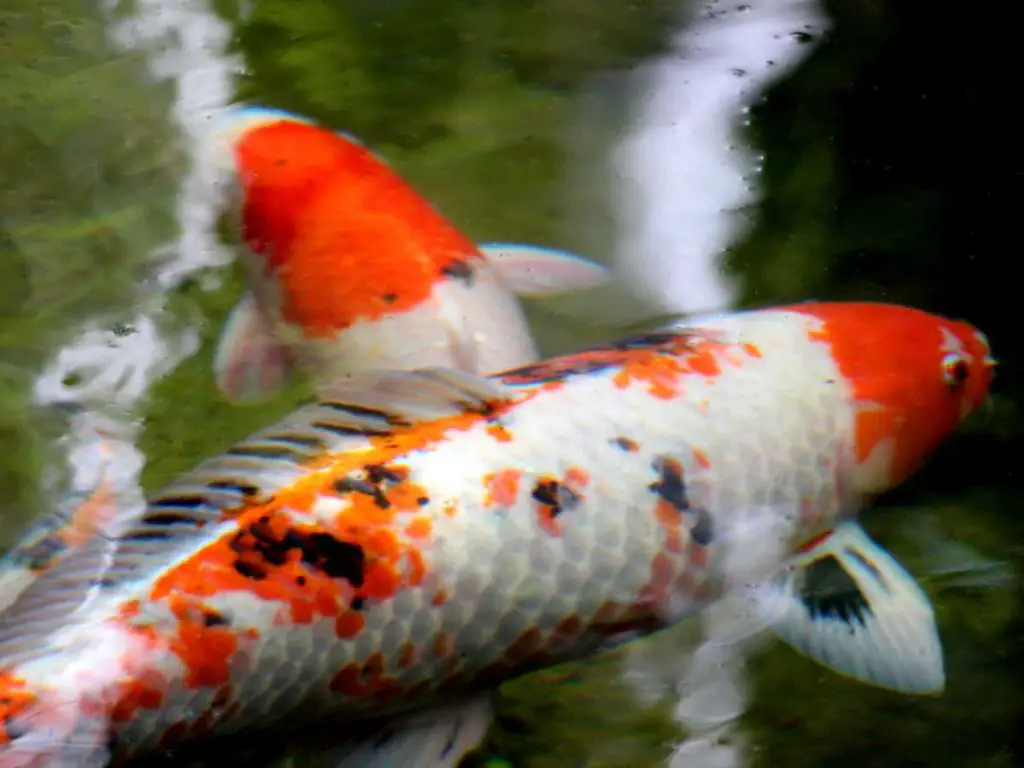
To truly grasp the intricacies of Sanke Koi care, it’s essential to delve into their natural habitat. Originating from the cold waters of Japan, Sanke Koi are accustomed to freshwater ponds and slow-moving streams nestled within the country’s serene landscapes. These waters are often clear, allowing sunlight to penetrate and nourish the aquatic plants, providing the Koi with both food and shelter.
The bottom of these natural habitats is a mix of mud and gravel, which Sanke Koi often sift through in search of small insects and crustaceans. The presence of various aquatic plants not only offers them a source of nutrition but also provides shaded areas, essential for protection against predators and excessive sunlight.
By understanding the conditions of their natural habitat, enthusiasts can better replicate an environment in captivity that meets the Sanke Koi’s innate needs. This knowledge ensures that the fish not only survive but thrive, displaying their full spectrum of colors and behaviors.
Sanke (Taisho Sanshoku) Koi Breeding Guide: Basics of Sanke Koi Fish Breeding
Have you ever wondered how to breed Sanke koi fish? Well, you’re in for a treat! Breeding these fascinating creatures can be a rewarding and exciting experience. Let’s get into the basics of Sanke koi fish breeding.
Required Conditions for Successful Breeding
First things first, before you begin breeding Sanke koi fish, you need to create the right conditions. This includes providing them with an appropriate tank setup, maintaining suitable water quality, and ensuring the proper temperature and lighting conditions.
Sanke koi fish thrive in spacious tanks with plenty of vegetation and hiding spots, so make sure to set up a tank that can accommodate both the adult fish and their offspring. The tank should also have adequate filtration and oxygenation systems to keep the water clean and oxygenated.
Identifying Mating Behaviors
Now that you have prepared the perfect environment for breeding, it’s time to look out for mating behaviors in your Sanke koi fish. During the breeding season, which typically occurs in spring or summer, male Sanke koi fish may chase females around the tank, displaying their brightest colors and fin displays.
If you notice this kind of behavior, it’s a good indicator that your fish are ready to mate. Keep a close eye on them and observe any egg-laying or courtship rituals, such as females laying eggs on aquatic plants or male fish nudging females towards the eggs.
Collecting and Caring for Eggs or Fry
Once your female Sanke koi fish has laid her eggs, it’s crucial to collect them promptly to prevent other tank inhabitants from eating them. Carefully transfer the eggs into a separate tank filled with aged, clean water to ensure their survival.
As the eggs hatch, you will have a tank full of wriggling fry. At this stage, it’s essential to provide them with suitable food, such as commercially available liquid fry food or small live organisms. Keep a close eye on their development and remove any unfertilized or unhealthy fry from the tank.
Raising Young Sanke Koi Fish
As your Sanke koi fry grow, it’s important to monitor their growth and provide them with a balanced diet. Gradually introduce them to solid foods, such as high-quality fish pellets or finely chopped live or frozen foods.
Regular water changes and maintaining optimal water quality are crucial for the health and growth of young Sanke koi fish. Keep an eye out for any signs of disease or stress, and consult a knowledgeable resource if you notice any issues.
Sanke Koi Tank Setup
Setting up the perfect tank for your Sanke koi fish is crucial to their well-being and happiness. Here are some key factors to consider when creating their aquatic paradise.
Tank Size and Shape
Sanke koi fish are known for their lively nature and need plenty of space to swim around. Aim for a tank that is at least 40-60 gallons to provide enough room for them to explore. A rectangular shape is ideal as it maximizes the surface area for oxygen exchange.
Water Filtration and Oxygenation Systems
Clean and oxygen-rich water is essential for the health of your fish. Invest in a reliable filtration system that can handle the size of your tank and efficiently remove waste and impurities. Consider adding a quality air pump to aerate the water, ensuring your Sanke koi fish get plenty of oxygen.
Decorations and Hiding Spots
Creating a visually appealing environment for your Sanke koi fish is important, but don’t go overboard with decorations that may restrict their movement. Include natural elements like rocks, plants, and driftwood, providing ample hiding spots for your fish to feel secure.
Temperature and Lighting Requirements
Maintaining the proper temperature and lighting conditions in your Sanke koi fish tank is crucial for their well-being. Install a reliable heater and thermometer to keep the water at the recommended temperature range of 70-75 degrees Fahrenheit. Use soft, indirect lighting with a timer to mimic their natural day-night cycles.
With the right tank setup, your Sanke koi fish will thrive in their aquatic home. Remember, investing time and effort into creating an optimal environment will greatly enhance their overall health and happiness.
Sanke Koi Feeding Habits
Feeding your Sanke koi fish is a vital aspect of their care, ensuring they stay healthy, happy, and vibrant. By understanding their feeding habits and providing the right diet, you can help your Sanke koi fish thrive in your pond or aquarium.
Appropriate Diet and Nutrition Requirements
Sanke koi fish are omnivores, which means they eat both plants and small animals. In their natural habitat, they consume insects, crustaceans, algae, and even smaller fish. When keeping Sanke koi fish as pets, it’s important to replicate their natural diet to promote their overall well-being.
Offering a well-rounded diet that includes high-quality commercial fish food, such as pellets or flakes, is essential. Look for fish food specifically formulated for koi or pond fish, as it will provide the necessary nutrients, vitamins, and minerals to support their growth and immune system.
Recommended Feeding Frequency and Portion Sizes
Typically, Sanke koi fish should be fed once or twice a day. However, it’s important to adjust the feeding frequency based on the temperature of the water and the activity level of the fish. In warmer temperatures during the summer months, Sanke koi fish tend to have a higher metabolism and may require more frequent feedings compared to colder months.
A good rule of thumb is to feed your Sanke koi fish an amount that they can consume within 5 minutes. Overfeeding can lead to poor water quality and health issues for your fish. It’s better to offer small portions at regular intervals rather than dumping a large quantity all at once.
Types of Food Suitable for Sanke Koi Fish
Sanke koi fish accept a wide range of foods, making them relatively easy to feed. In addition to commercial fish food, you can also supplement their diet with fresh or frozen options:
- Live or frozen brine shrimp
- Daphnia and bloodworms
- Chopped fruits and vegetables (e.g., peas, lettuce, watermelon)
- Commercially prepared koi treats or snacks
It’s important to vary their diet to ensure they receive a good balance of nutrients. Remember to remove any uneaten food from the pond or aquarium to prevent water pollution and maintain water quality.
Identifying Sanke Koi Colors and Patterns
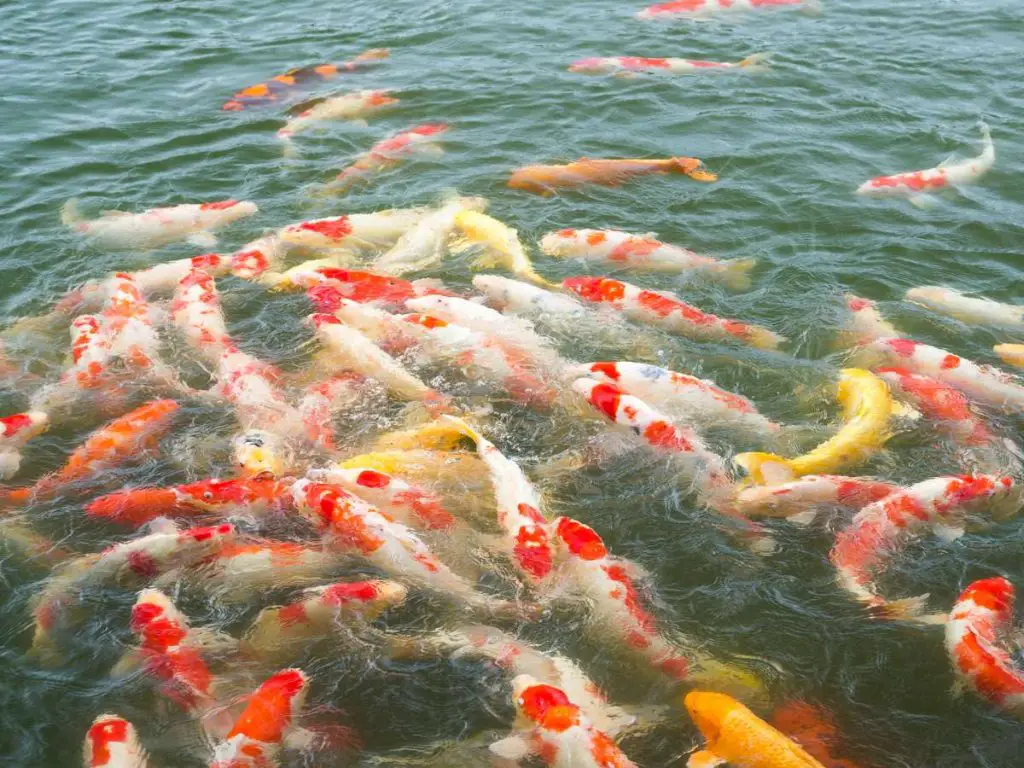
When it comes to Sanke koi fish, one of the most fascinating aspects is their incredible range of colors and patterns. These beautiful creatures come in a variety of captivating hues, making them a prized addition to any pond or aquarium.
Whether you’re a seasoned Sanke koi enthusiast or just starting out, knowing how to identify different color variations and patterns is essential to fully appreciate their beauty. Here’s a quick reference guide to start out with:
| Variety | Description |
|---|---|
| Aka Sanke | Majority of head and back covered in red. Black markings (Sumi) can be anywhere on the body. |
| Tsubo Sumi | Black markings only on white parts of the koi. Red coloration is present, but black markings are not within these red areas. |
| Nidan | Features two separate red patches, often resembling “stepping stones”. One near the head and the other closer to the tail. Black markings can be on both red or white parts of the back. |
| Sandan | Three unconnected red islands running from the tail to the head. Black markings can be anywhere on the upper part of the body. |
| Yondan | Four separate red patches running along the dorsal side. Black patterns can be on any part of the upper body, either on red or white areas. |
| Doitsu | Lacks scales, except for some along their lateral line and dorsal fin. Can exhibit any of the above patterns or a combination. |
| Tancho | Features a single red marking on the head, resembling a “red sun”. The body is white with black markings only on the white parts. No red on the body and no black within the red spot on the head. |
| Kuchibeni | Known as the “lipstick” pattern, these koi have red markings around their mouth. Black markings are present on the body. |
| Menkaburi | A “face mask” or “hooded head” pattern where a large red patch covers the top of the head, extending below and behind the eyes, possibly reaching the mouth. Black markings can be on both red or white areas. |
| Maruten | Characterized by a red “crown” spot on the head and additional red patches on the body. Black patterning can be found anywhere on the back, either on red or white areas. |
Common Sanke Koi Color Variations
Sanke koi fish can display a stunning array of colors, with each variation having its own unique charm. Here are some of the most common color variations you may come across:
- Kohaku: This classic coloration features a bright white body contrasted with vibrant red markings. It’s a timeless combination that never fails to impress.
- Tancho: Tancho Sanke koi fish are characterized by a solitary red dot on their heads. It’s often said that the simplicity of this pattern brings out the true elegance of these majestic creatures.
- Showa: Showa Sanke koi boast a striking blend of black, red, and white markings. The symphony of colors creates a breathtaking spectacle that captures attention wherever they go.
- Kumonryu: Known as the “dragon fish,” Kumonryu features a dramatic black and white pattern that resembles wisps of smoke swirling in water. This color variation is truly mesmerizing.
- GoSanke: GoSanke is not a specific color variation, but rather refers to any Sanke koi fish that embodies three primary colors: red (hi), white (shiro), and black (sumi). The combination of these colors creates a harmonious and visually stunning effect.
Identifying Sanke Koi Patterns
In addition to their colors, Sanke koi fish can also exhibit fascinating patterns that add another layer of visual intrigue. Here are some common patterns you might encounter:
- Scaleless: This unique pattern lacks the typical scales seen on most Sanke koi fish. Instead, the skin appears smooth and shimmering, enhancing their overall beauty.
- Ghost: Ghost Sanke koi feature a semi-transparent body with faint, shadow-like markings. It’s as if they exist between two worlds, making them truly ethereal.
- Maruten: Maruten Sanke koi have a single circular marking on their heads, often resembling a crown or halo. This distinctive pattern adds an element of regality to their appearance.
- Ogon: Ogon Sanke koi are characterized by their metallic sheen, displaying a solid color that shimmers in the light. Their simplicity exudes elegance and sophistication.
- Asagi: Asagi Sanke koi showcase a unique pattern consisting of a blue-gray body with vibrant red or orange patterns on their abdomens. It’s a captivating contrast that never fails to draw attention.
Understanding the various colors and patterns that Sanke koi fish can possess allows you to appreciate their individuality and diversity. Whether you have a specific preference or simply enjoy admiring these magnificent creatures, being able to identify different color variations and patterns will bring you closer to the fascinating world of Sanke koi fish.
How to Judge Sanke Koi
Sanke Koi are judged based on a set of specific criteria, many of which are shared with the Kohaku variety. Here’s a breakdown of the key considerations:
- Head Markings: Sanke Koi should ideally not have any black (Sumi) markings on their head. While some judges might overlook this if it adds a sense of balance to the fish, it’s generally seen as a less desirable trait. The red (Hi) markings shouldn’t extend too far down the head.
- Body Markings: The Sumi markings shouldn’t go beyond the caudal peduncle, which is the narrow part where the tail fin joins the body. The white (Shiro) areas of the fish should be a pure white, without any yellowish hue.
- Physical Health: Any abnormalities, like missing fins, a deformed mouth, or bruises (unless caused during transportation), are undesirable. The fish should also be free from parasites, ulcers, or any signs of illness.
- Pattern Symmetry: Symmetry plays a crucial role in judging. The Hi and Sumi patterns should be balanced from front to back and side to side, ensuring the fish doesn’t appear lopsided. Unique patterns are appreciated. The fish’s head and fins should also be proportionate and symmetrical.
- Pattern Position: Hi plates and Sumi markings should be positioned high on the fish’s head or back and shouldn’t extend below the lateral line, roughly aligned with the ribs. The only exception is the Kuchibeni Sanke, which has red around its mouth. If there’s black on the head, it’s likely a Showa koi, not a Sanke.
- Color Intensity: The exact shade of the Hi plates can vary from orange to bright cherry-red. Consistency in shade across all Hi plates is essential. Some judges might have a preference for a particular shade of red. The Sumi markings should be as dark as wet ink.
- Sumi Appearance: Instead of large blocks, the Sumi markings should resemble gentle brush touches on the koi’s body. The markings shouldn’t appear as if they’ve been stroked heavily or poured in large patches.
In essence, a well-balanced, symmetrical pattern, combined with vibrant colors and good health, makes a Sanke Koi stand out in competitions.
Final Thoughts
The enchanting world of Sanke Koi offers a blend of natural beauty, tranquility, and a testament to the rewards of diligent care. These ornamental fish, with their vibrant patterns and colors, are more than just aquatic pets; they symbolize harmony, perseverance, and the delicate balance of nature.
Ensuring your Sanke’s well-being is a commitment that requires knowledge, patience, and a genuine appreciation for their unique needs. As we’ve explored, the journey of Sanke Koi care is multifaceted, encompassing everything from their diet to their habitat.
Embracing this journey not only ensures the health and longevity of these aquatic jewels but also deepens our connection with the natural world.
Key Takeaways:
- Sanke Koi are ornamental fish known for their vibrant colors and patterns.
- Proper care, including water quality and diet, is crucial for their well-being.
- Sanke Koi are susceptible to certain diseases, but with preventive measures, risks can be minimized.
- A well-maintained habitat enhances the longevity and beauty of Sanke Koi.
- Understanding and catering to their specific needs creates a harmonious environment.
- Regular monitoring and maintenance are essential for optimal Sanke Koi health.
- Breeding Sanke Koi requires specific conditions and careful observation.
- Recognizing the various colors and patterns of Sanke Koi deepens appreciation and knowledge.
- Sanke Koi care is a rewarding experience, fostering a bond between the keeper and the fish.
Related Questions
Can Sanke koi fish be kept with other types of fish in the same aquarium?
Yes, Sanke koi fish can coexist with other peaceful fish species as long as their tank mates are not aggressive or known to nip at fins. It is important to choose compatible fish that have similar water temperature and pH requirements to ensure a harmonious environment.
How long do Sanke koi fish live?
Sanke koi fish have an average lifespan of 10 to 15 years, although with proper care, some individuals have been known to live up to 20 years or more. Providing a suitable habitat, practicing good nutrition, and regular maintenance of their aquarium will contribute to their longevity.


